
hotline:
17715390137
Tel/Wechat:
18101240246 (Technology)
0512-68565571
Email:mxenes@163.com (Sales Engineer)bkxc.bonnie@gmail.com
Scan the code to follow or search the official account on WeChat:
2D Materials Fronrier After paying attention,
click on the lower right corner to contact us,
Enter enterprise WeChat.
Professional Services Online

The transformation of layered transition metal carbides and / or nitrides (mxenes) into zero dimensional structures with thickness and transverse size of several nanometers enables these materials with excellent electronic properties to develop additional advantages of quantum confinement, edge effect and large surface area. However, conventional methods for converting mxene nanosheets and quantum dots involve extreme conditions, such as high temperature and / or irritating chemicals, which, among other disadvantages, lead to significant degradation of materials due to oxidation.
Full text guide
In view of this, Professor Leslie y. Yeo of Royal Melbourne Polytechnic University of Australia reported a chemical free acoustic microfluidic method for stripping single or few layers of ti3c2tz mxene nanosheets at room temperature and converting them into mxene quantum dots (mqd), so as to minimize their oxidation and maintain the integrity of the material. Compared with the highly oxidized samples synthesized by traditional hydrothermal method, the high purity mxene quantum dots produced by this room temperature chemical free synthesis method show excellent performance as electrode materials for hydrogen peroxide electrochemical sensor. The measured concentration is as low as 5 nm, which is 10 times of the best performance reported so far based on ti3c2tz mxene electrochemical sensor. The results of related papers were published on ACS Nano on June 29, 2021 with the title of acoustomicrofluidic synthesis of pristine ultrathin ti3c2tz mxene nanosheets and quantum dots .
This method (as shown in Fig. 1) relies on the use of a recently discovered class of nano amplitude high frequency (MHz level) mixed acoustic waves, called surface reflectors wave (srbw), which can be used to manipulate fluids and bulk and 2D crystals, to peel bulk transition metal disulfides, and to peel ti3alc2tz quantum dots from ti3alc2tz. Compared with the previous work, surface acoustic wave (SAW) plays a role in promoting the protonation of lithium fluoride to hydrofluoric acid, which in turn selectively etches Al from Ti3AlC2 to transform it into ti3c2tz. This work demonstrates a direct mechanical stripping method to cut multiple layers of mxene laterally into single and few layers of nanosheets and mqds without the need for chemical or organic bases such as tetrabutylammonium hydroxide or in-situ intercalation agents.
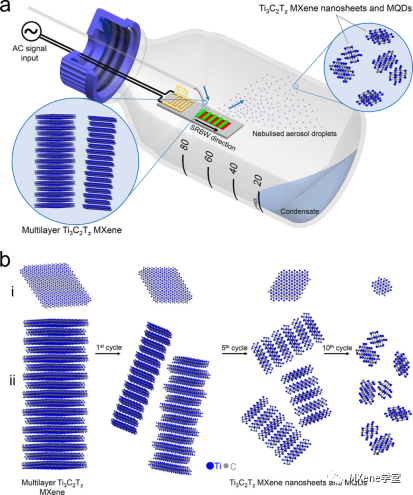
Fig. 1 shows: (a) the schematic diagram of the experimental device, in which the multi-layer ti3c2tz mxene samples are continuously transported to the srbw device and atomized at the top to form stratified and cracked ti3c2tz aerosol droplets, which condense in the glass bottle shell( b) Continuous re atomization of the condensate collected in multiple cycles was observed (I) transverse cutting and (II) delamination of the sample into smaller and thinner mxene nanosheets and mqds.
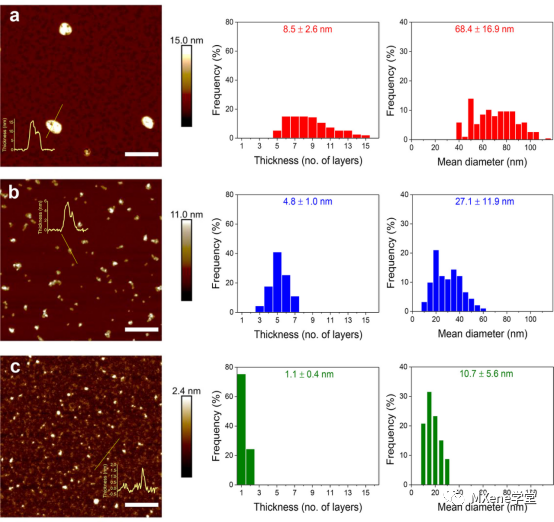
Figure 2 shows the typical AFM images of mxene nanosheets and mqd synthesized after 10 atomization cycles (a) 1, (b) 5 and (c) and the corresponding thickness (middle) and average transverse diameter (right) measurement distributions.
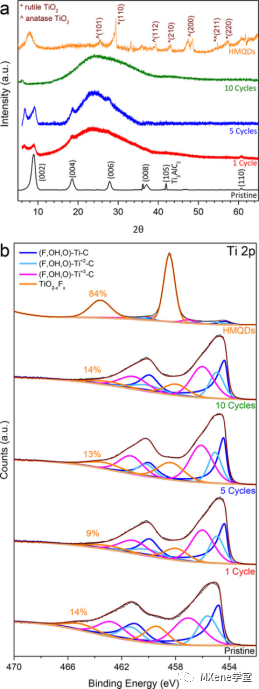
Figure 3 shows: (a) the (a) XRD and (b) high-resolution XPS (Ti2P region) of the original multi-layer mxene raw materials, mxene nanosheets after 1 and 5 atomization cycles, mqd and hmqd (hydrothermal synthesis of quantum dots) after 10 atomization cycles. The area percentage of TiO2 XFX in each case is also indicated in the XPS spectrum.
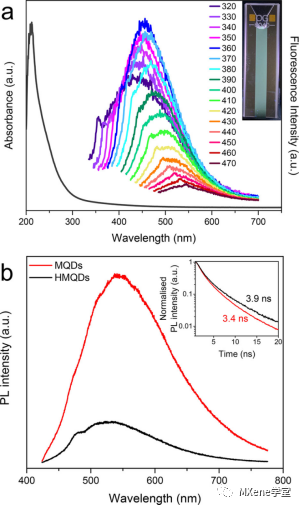
Figure 4 shows: (a) UV Vis absorption (black curve, left axis) and fluorescence emission (color curve, right axis)( b) Photoluminescence (PL) spectra of acoustically synthesized mqd were obtained after 10 atomization cycles. In (a), the excitation dependent fluorescence emission is obvious, and the maximum value appears at 360 nm excitation; The illustration shows an image of the mqd suspension excited by a 365 nm UV lamp( b) The excitation wavelength is 400 nm; The corresponding spectra of hmqd are also shown. Due to its high TiO2 XFX composition, the PL emission intensity of hmqd is significantly weaker; From the PL attenuation curve shown in the illustration, the corresponding lifetimes of mqd and hqmd are 3.4 and 3.9 ns, respectively.
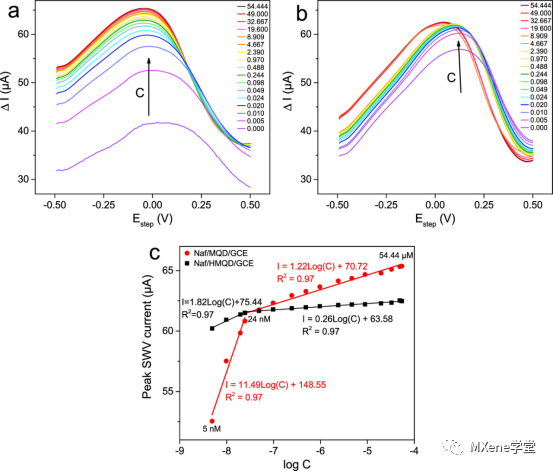
Figure 5 shows the square wave voltammetric curves of (a) NaF / mqd / GCE and (b) NaF / hmqd / GCE configurations in 0.1 M PBS and different H2O2 concentrations; The arrow shows the observed trend of increasing H2O2 concentration( c) Current response and H2O2 detection potential of NaF / mqd / GCE (red line) and NaF / hmqd / GCE (black line) configurations.
summary
Mxene nanosheets and quantum dots provide the possibility to combine the advantages of enhanced electronic properties, high conductivity and excellent electrochemical activity with the advantages of quantum confinement, edge effect and large surface area. The conventional methods of synthesizing these materials, including solvothermal and hydrothermal methods, not only take a long time and require high temperature and dangerous chemicals, but also lead to the oxidation of samples into TiO2, which greatly reduces the purity of materials and leads to the degradation of their performance in various applications. In this work, we report a chemical free room temperature synthesis method, in which multiple layers of mxene are layered into single layers of mqd by high mechanical force of sample atomization driven by high frequency acoustic waves. In addition to the relatively fast synthesis time, due to the small footprint and low cost of chip level devices (by taking advantage of the economies of scale associated with large-scale nano manufacturing, this method can be easily extended by parallelizing large-scale devices). More importantly, mqd synthesized by this technology will not be oxidized obviously. In addition to the strong ultraviolet absorption and excitation dependent fluorescence, the high purity of the material leads to its better performance as an electrochemical sensing electrode material, especially for H2O2, which shows that the detection concentration can be as low as 5 nm, which is the lowest value of ti3c2tz mxene electrochemical sensor so far.
This information is from the Internet for academic exchange only. If there is any infringement, please contact us to delete it immediately

| Reminder: Beijing Beike New Material Technology Co., Ltd. supplies products only for scientific research, not for humans |
| All rights reserved © 2019 beijing beike new material Technology Co., Ltd 京ICP备16054715-2号 |